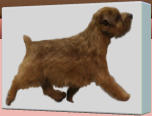

Breeders Corner

Kafka said, "All knowledge, the
totality of all questions and
answers, is contained in the dog."

Please submit your article,
publication or hyperlink to an
article to Judi Hartell.
DataDawg@Austin.rr.com
Submissions

Quote



The Bluebonnet Norfolk Terrier Club does not recommend,
guarantee, endorse, nor rate these recommendations or
contributors, their kennel or their stock. The purpose of this section
is to share the knowledge and experience of breeders who have vast
experience in whelping and raising puppies. The tips and tricks
below are intended to augment qualified veterinarian care, not as a
substitute for qualified veterinarian care of the dam and puppies.




From Good Dog, Bad Gene: Sue Pearce-Kelling, president of Optigen, says that breeders
are often dismayed to the point of overreacting when a disease is identified in their breed.
Advice from breed clubs having experienced this is reassuring. "Once it becomes clear that
the DNA test will allow them to continue to breed any of their dogs and still be assured of
avoiding disease, they realize they can retain the good qualities and gradually move away
from the disease over time," says Pearce-Kelling. "If they want to breed a dog that carries a
recessive mutation, they simply need to choose a mate that does not carry that mutation, and
then choose 'clear' offspring from that generation or a following one."

PEDIGREE ANALYSIS
Geneticists' and breeders' definitions of inbreeding vary. A geneticist views inbreeding as a
measurable number that goes up whenever there is a common ancestor between the sire's
and dam's sides of the pedigree; a breeder considers inbreeding to be close inbreeding, such
as father-to-daughter or brother-to-sister matings. A common ancestor, even in the eighth
generation, will increase the measurable amount of inbreeding in the pedigree.
The Inbreeding Coefficient (or Wright's coefficient) is an estimate of the percentage of all the
variable gene pairs that are homozygous due to inheritance from common ancestors. It is also
the average chance that any single gene pair is homozygous due to inheritance from a
common ancestor. In order to determine whether a particular mating is an outbreeding or
inbreeding relative to your breed, you must determine the breed's average inbreeding
coefficient. For the calculated inbreeding coefficient of a pedigree to be accurate, it must be
based on several generations. Inbreeding in the fifth and later generations (background
inbreeding) often has a profound effect on the genetic makeup of the offspring represented by
the pedigree.






- Behavior
- Honor Roll
- Living With Norfolk Terriers
- Fun With Your Norfolk
- Tip Of The Week
- Publications
- Therapy and Service Dogs
- Health & Nutrition
- Competition


- Books
- Clubs
- Collectibles, Gifts & Fun Activities
- Companion Animal Recovery
- Dog Show Superintendents
- Genetics
- Health Related Sites
- Canine Health Links
- Vaccination Protocols
- Animal Health Trust
- Online Mendelian Inheritance In Animals
- Univ. Of Cambridge Vet. School
- Canine Inherited Disorders Database
- All Creatures Veterinary Hospital
- A First Aid Kit
- Veterinary Pet Insurance
- AKC Pet Health Plan
- Cornell Univ. College of Vet. Medicine
- More Health Related Sites
- Independent Sites
- Pet Travel
- Training Your Puppy
- Publications


- Breeding Tips
- Breeding Tips Page One
- Breeding Tips Page Two
- Breeding Tips Page Three
- Breeding Tips Page Four
- Breeding Tips Page Five
- Breeding Tips Page Six
- Virus &The Pregnant Bitch
- Dog Neutering Video
- Vaccinations & The Pregnant Bitch
- Incontinence In The Pregnant Bitch
- Flagyl & The Pregnant Bitch
- Canine Reproduction
- Frozen vs Chilled Semen
- Modern Breeding Management
- Dialogue On Rasberry Leaves
- Monitoring Pregnancy
- Uses For Vaginal Cultures
- OFA & The Pregnant Bitch
- Breeding Tips Page Seven
- Breeding Tips Page Eight
- Breeding Tips Page Nine
- Breeding Tips Page Ten
- Breeding Tips Page Eleven
- Breeding Tips Page Twelve
- Breeding Tips Page Thirteen
- Breeding Tips Page Fourteen
- Genetics And Inheritance
- Rescue









